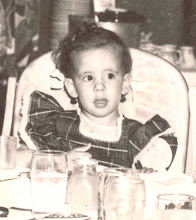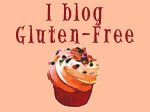Since avoiding gluten consumes my Naked Fork life, it must be given some due here.
 Gluten is present in wheat, rye, barley and malt (and, due to contamination from harvesting and storage, also in most oats). Gluten is the molecule that gives texture to breads and other baked goods and makes these things yummy! It enables baked products to hold together and expand in cooking.
Gluten is present in wheat, rye, barley and malt (and, due to contamination from harvesting and storage, also in most oats). Gluten is the molecule that gives texture to breads and other baked goods and makes these things yummy! It enables baked products to hold together and expand in cooking. People who have CELIAC DISEASE cannot consume any gluten, not even a crumb.
The first time you eat a gluten-free ("GF") slice or bread or a cookie, the initial shock is when it turns into dust the instant you bite into it.
Whoo boy. The U.S. press has gotten hold of "gluten," and is this ever a mixed blessing! For those who have Celiac Disease (more than 2 million in the U.S., 97% of whom do not know they have it), the press coverage is great in getting more information out there -- with discussion of symptoms and explanations to the rest of the world of how involved and difficult it is to live without gluten.
However, as the press grabs up and ultimately sullies nearly everything, "not eating gluten" is suddenly being touted as the latest fad (see: Top Ten 'Yuppie' Health Conditions), lessening the public's opinion of what is a very serious disease for many. But on the other hand, the more people who are actively seeking to avoid gluten, the more pressure there is on food manufacturers to produce true and palatable gluten-free foods (a fledgling industry, at best, in need of some serious palate and taste guidance).
There is a lot out there written about Celiac Disease and gluten -- so I do not intend to squeeze a treatise on this subject into my little blog.
Here are some of the best informational sites, if you are interested in finding out more:
- GIG (Gluten Intolerance Group® of of North America)
And here is the best book written on Celiac Disease ...
CELIAC DISEASE: A HIDDEN EPIDEMIC by Peter H.r.Green and Rory Jones

For decades, European countries and their governments have recognized Celiac Disease as a major medical condition. It has taken the U.S. a long time to catch up, but it is finally happening. As a result, much is available now to read and learn about gluten and Celiac Disease. Most people who are in this fix have already read it all -- so I won't be paraphrasing it here.CELIAC DISEASE: A HIDDEN EPIDEMIC by Peter H.r.Green and Rory Jones

I will limit myself to just a short list of personal observations to share with those who don't have to live this life:
- Gluten is present in almost everything. If it is not an actual ingredient, so many packaged, canned and bottled goods are cross-contaminated by it. Surprising foods that contain gluten are: soy sauce, beer, many sauces and salad dressings, French fries at just about any restaurant (because they are fried in the same oil with wheat-battered items) and many veined cheeses (due to using wheat bread to start a culture).
- There is no such thing as a "little" gluten. One must strive to eliminate every bit of gluten possible. Gluten is not always listed among ingredients on food labels, so hours and hours of research are necessary to know what foods are gluten free.
- A growing number of restaurant chefs, managers and waitrons understand about gluten, and go out of their way to help one eat gluten free -- almost like a normal person. My message to you, and you probably know who you are: YOU ROCK!
- My fantasy "last-meal-before-execution" (in the event I ever eat a Twinkie and "accidentally" off someone): KFC (Original Recipe, of course), a Taco Bell Crunchwrap Supreme and genuine San Francisco sourdough bread.
- Never let it be said that I cannot see a silver lining in all of this. Having to eat gluten free forces one to look to freshly prepared foods, and to give up an awful lot of junk food -- usually riddled with gluten. Instead of seeking my jollies in a Big Mac with Fries, I'm far more likely to get excited over really great freshly prepared meat or fish, with a wonderful salad of organic baby greens with a sprinkling of nasturtiums, plus freshly roasted gold and red beets with thick aged balsamic vinegar and Greek EVOO. (Oh, yeah, right ... unfortch I can't get the latter for 3 bucks. Whoops! Where did that silver lining go all of a sudden?)












